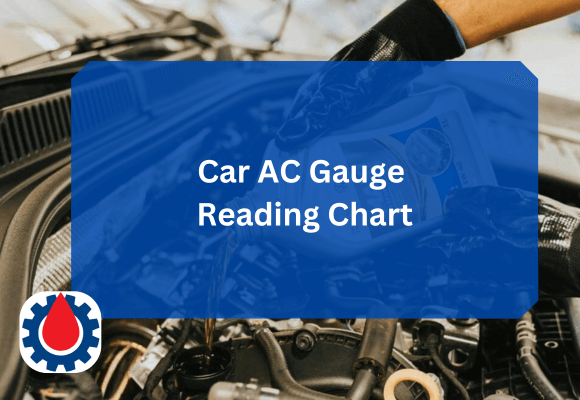One of the most effective ways to diagnose AC performance is by using an AC manifold gauge set to measure system pressure. These readings help determine whether your system is properly charged, overcharged, or suffering from leaks or component failures.
Below is a comprehensive guide explaining car AC gauge readings, complete with a detailed chart for R134a and R1234yf refrigerants used in most modern vehicles.
Car AC Gauge Reading Chart
| Ambient Temperature (°F) | Low Side (R134a) | High Side (R134a) | Low Side (R1234yf) | High Side (R1234yf) | System Condition / Diagnosis |
|---|---|---|---|---|---|
| 70°F (21°C) | 30–35 psi | 150–190 psi | 28–33 psi | 140–180 psi | Normal system pressure |
| 75°F (24°C) | 35–40 psi | 175–210 psi | 32–38 psi | 165–200 psi | Proper charge, cooling OK |
| 80°F (27°C) | 40–45 psi | 200–235 psi | 36–42 psi | 190–225 psi | Slightly higher pressure due to heat |
| 85°F (29°C) | 45–50 psi | 225–250 psi | 40–46 psi | 210–240 psi | Normal in moderate heat |
| 90°F (32°C) | 45–55 psi | 250–275 psi | 43–48 psi | 235–260 psi | Working efficiently under load |
| 95°F (35°C) | 50–55 psi | 275–300 psi | 45–52 psi | 250–280 psi | Normal at high ambient temperature |
| 100°F (38°C) | 50–60 psi | 300–325 psi | 48–55 psi | 270–300 psi | Hot weather; system OK if cooling |
| 105°F (41°C) | 55–65 psi | 325–350 psi | 52–58 psi | 295–320 psi | High readings due to heat load |
| 110°F (43°C) | 60–70 psi | 350–400 psi | 55–62 psi | 310–350 psi | Near upper limit; check for airflow |
| Below 60°F (15°C) | 20–30 psi | 100–150 psi | 18–28 psi | 90–140 psi | Low ambient; avoid testing below 60°F |
Related AC System Pressure Chart(For All Refrigerant Types)
How to Read Car AC Gauges Step-by-Step
1. Connect the Gauges
- Attach the blue hose to the low-pressure port (larger pipe).
- Attach the red hose to the high-pressure port (smaller pipe).
- Ensure connections are snug to avoid leaks.
2. Start the Engine & Turn AC to MAX
- Set the fan to the highest setting and the AC to recirculate.
- Let the system run for 3–5 minutes.
3. Read the Gauges
- Observe both low and high pressure readings.
- Compare them to the chart above to assess the system’s health.
4. Interpret the Results
- If readings are outside the normal range, identify the probable issue (leak, blockage, compressor failure, etc.).
5. Recharge or Repair if Needed
- Add refrigerant if undercharged, or evacuate and refill if overcharged.
- Always use the correct refrigerant type and follow safety procedures.
Related Low Engine Oil Pressure(8 Common Causes & Solutions)
Common Symptoms of Incorrect AC Pressure
| Symptom | Likely Cause | Gauge Reading |
|---|---|---|
| Weak cooling or warm air | Low refrigerant | Low both sides |
| Compressor cycling rapidly | Low charge or leak | Low pressure spike |
| AC clutch not engaging | Electrical issue | Zero pressure or sensor fault |
| High pressure cut-off | Overcharge or poor airflow | High both sides |
| Frost on lines or vents | Blocked expansion valve | Low low-side pressure |
Maintenance Tips for Accurate Readings
- Always test with the engine running and AC at full blast.
- Ensure condenser fans are operational, non-functioning fans can falsely raise pressure readings.
- Use a reliable manifold gauge set and verify calibration regularly.
- Check the ambient temperature before interpreting results, high outside temperatures naturally raise system pressure.
- Replace AC filters and clean condensers regularly for consistent cooling.
Related Engine Oil Consumption Calculator
FAQs
What is the normal gauge for a car AC?
The normal gauge reading for a car AC system typically shows 25–45 psi on the low-pressure side and 200–250 psi on the high-pressure side when operating under normal conditions with R134a refrigerant at around 80°F ambient temperature. These values vary depending on temperature, humidity, and the type of refrigerant used.
Lower readings indicate undercharging or a leak, while higher readings suggest overcharging or restricted airflow through the condenser.
What should my AC gauges read on a car?
When your car’s AC system is running properly, the low-side gauge should read between 30 and 40 psi, and the high-side gauge should read between 200 and 250 psi. These readings assume the system is fully charged, the compressor is working correctly, and the ambient temperature is moderate (around 75–85°F). If the readings are far outside these ranges, you may have a refrigerant imbalance, a blockage, or a faulty compressor.
Related Transmission Fluid Temperature Chart(Comprehensive Guide)
How to read an AC recharge gauge?
To read an AC recharge gauge, connect it to the low-pressure service port (the larger pipe) while the engine and AC are running at maximum cooling. The gauge will show pressure in psi (pounds per square inch).
- If the reading is below 25 psi, your system is low on refrigerant.
- If the reading is above 45 psi, it may be overfilled or have a restriction.
- Always consult a temperature-to-pressure chart for accurate readings based on ambient temperature and refrigerant type before adding refrigerant.
What is a normal AC reading?
A normal car AC reading depends on the ambient temperature and refrigerant type, but generally:
- Low side: 25–45 psi
- High side: 200–300 psi
- If readings fall within these ranges and the system blows cold air, your AC is functioning normally. However, if the low side is too high or the high side too low, it may indicate a compressor issue, blockage, or incorrect refrigerant charge.
How to check if car AC is good?
To check if your car’s AC is in good condition, start the engine, set the AC to maximum cooling, and connect a manifold gauge set. Compare the low and high pressure readings to the standard chart.
You should feel cold air from the vents and see normal gauge readings (around 30–40 psi low side and 200–250 psi high side). Also, check that the compressor clutch engages, there are no leaks, and the condenser fans are operating properly.
Related Engine Oil Temperature Chart(Complete Guide)
Final Thoughts
Understanding your car AC gauge readings can help you pinpoint refrigerant and pressure issues before they lead to costly repairs. The chart above serves as a universal reference for both R134a and R1234yf systems, showing how temperature directly affects pressure levels. Regularly checking your system ensures it operates efficiently, keeping your vehicle cool even in the hottest conditions.




